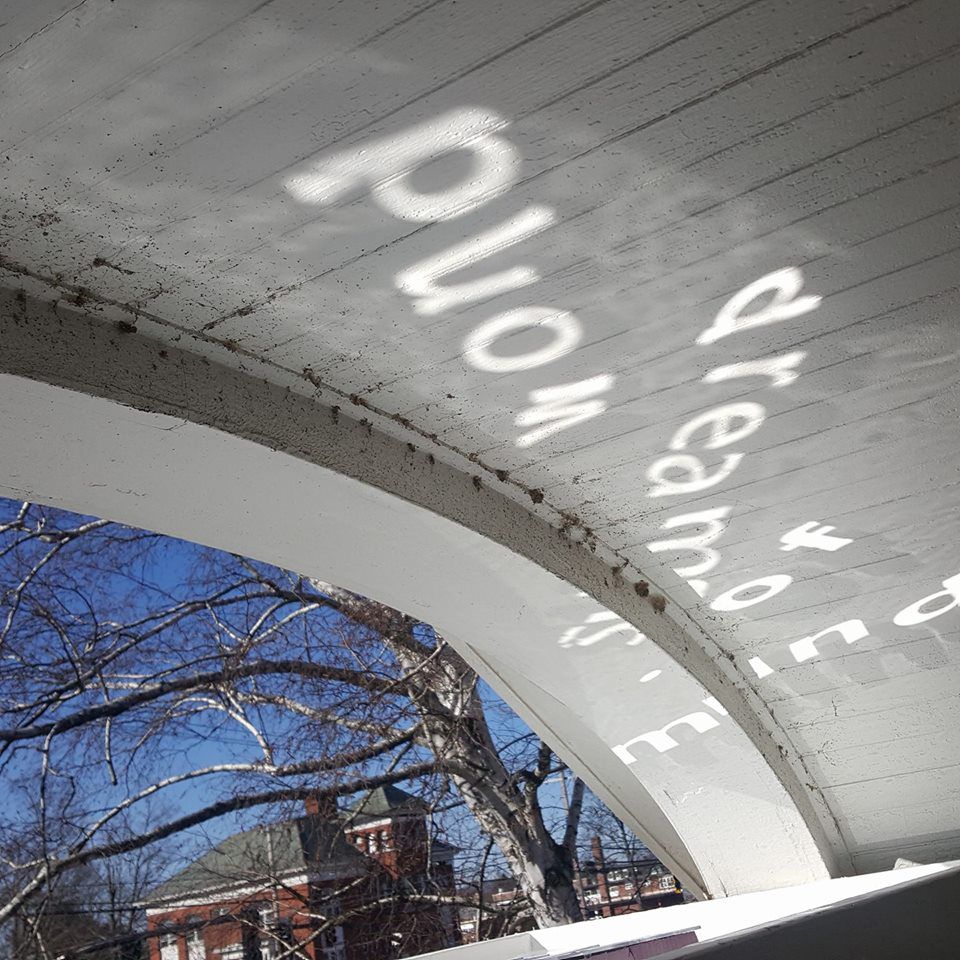Hadley Town Commons is sleepy and quaint and on one of the four corners of the intersection of Routes 47 and 9, sits the historic Goodwin Memorial Library. It’s a brick building, unassuming, old, and encumbered by time. The Goodwin, however, is slated for enormous changes; last summer the library was awarded a $3.9 million provisional construction grant to replace the current 4,500 square foot building into a modernized 11,800-square-foot library with 40 parking spaces.
As it stands, however, there are only nine parking spaces on the side of the building, and the Goodwin is an undoubtedly interesting place to choose to book an art show. Upon entering, you immediately notice that there is no particular space in the building that can be dedicated to an exhibit. But somehow Chris Janke has made a way to exhibit his work in this highly improbable space.
Janke, a UMass professor who is also a poet and a visual artist, combines his pursuits in a most interesting way. In his exhibit entitled Transit, he challenges the viewer to use not only imagination to fill in the blanks, but to play a game of hide and seek. The show is a marriage between words, the sun, and the sun’s motion. The viewing is driven by the time of day, the angle of the sun, and the day’s cloud coverage. What you see will change and, at some point, cease to exist.
The installation begins on the outside of the building. Entering the south-facing entrance, a glance upward to the arch of the portico reveals the sunlit words “dreams” and “mind.” There are other words, but because of the sun’s angle at the time, they are only partially visible. Surrounding the words is the sun dappled reflection of water. The constant motion is a bit hypnotic and extremely pleasant.
Inside the building is where things get tricky and the first order of business is to collect Janke’s instructions on how to view his exhibit. It will serve as a trusty companion. Climbing the narrow wooden stairs to the right, the viewer encounters plastic panes of etched text situated on small scaffolding directly adjacent to a window. Though the sun is bright, it’s angle is not cooperating with this particular segment of the installation; there are no reflections. It’s disappointing but intriguing.
The top level of the Goodwin Memorial Library is just odd; it looks more like a store room than a library. At first blush, there is no rhyme or reason to the set up — a large work table pushed off toward the perimeter and oddly situated display cases that house library stationary. Janke’s guide to his installations, however, gives a hint as to why this room seems so clumsy. On the westward facing windows on the second floor, the words “passes through” and “word” await the sun’s illumination to cast reflections on the floors of the first and second levels. They are not visible at that point, but that’s when imagination has to take over and perhaps spur the viewer to return to see the exhibit’s full manifestation.
At every point in this exhibition, it’s imperative for the viewer to have in possession Janke’s guide. In particular, the last piece of Janke’s map is necessary to ascertain his intents and purposes. And he saves the best for last.
Upstairs on the south wall of the Goodwin is a large war memorial dedicated to the men who served from the town of Hadley. It’s difficult to miss: the Revolutionary War, Civil War, World War I. A dedication reads, “Hadley in the Three Wars … The Brave Live On.” And this is where Transit takes a peculiar turn, for Janke moves into the socio-politico realm by highlighting the history of Hadley’s settlement.
“In a powerful way, the creation of Hadley from what was once … Nonotuck was a movement of one knowledge nearly destroying another…. And it’s hard to ignore that this knowledge served as a justification for a genocidal action.” He concludes, “I present this work as a kind of homage to the mystery of knowledge, of internal experience whatsoever, but also as an effort to challenge the colonized version of history presented on the south wall on the second floor.”
Janke gives reason to pause and reflect. During our dulled travels through the rural roads of Massachusetts and the paved highways across the country, we rarely remember what was destroyed in order for manifest destiny to succeed.
The mystery of time’s movement, the ability of time to bury the truth, and man’s insatiable desire to sanitize history are as formidable as securing the sun’s cooperation. And even though you may not catch all the luminous wonders of Janke’s Transit, you leave with an understanding: What at first appeared quite quaint has been transformed by the shadow of a bleak history.
Gina Beavers can be reached at gbeavers@valleyadvocate.com.



